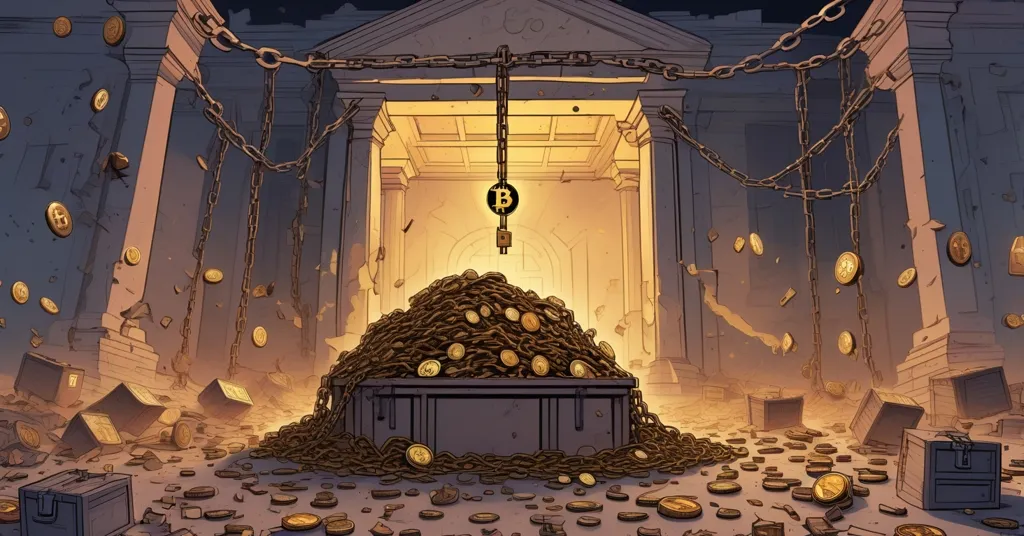FTX Creditor Payout Set for Sept 30, 2025 Amid Legal Battles and $800M Restrictions

FTX Prepares for Next Creditor Payout Amid Legal Firestorms and Trust Deficits
Billions lost, trust obliterated, and now a gauntlet of red tape to recover mere pennies on the dollar—that’s the grim reality of the FTX collapse. On September 30, 2025, the disgraced cryptocurrency exchange will launch its next round of cash distributions to creditors, a small lifeline after repaying $6.2 billion already. But with a $1.9 billion cut to its disputed claims reserve offering hope, legal battles over payout restrictions in 49 jurisdictions—especially China—threaten to leave many empty-handed. Let’s unpack this latest chapter of crypto’s ugliest catastrophe.
- FTX Payout Date: Distributions kick off on September 30, 2025; record date for eligibility is August 15, 2025.
- Reserve Slash: Bankruptcy Court cuts disputed claims reserve from $6.5B to $4.3B, freeing cash for creditors.
- Legal Standoff: Chinese creditor Weiwei Ji, among others, fights restrictions on $800M in claims across 49 regions.
Navigating the FTX Creditor Payout Maze
Since FTX imploded in November 2022 under a crippling liquidity crisis, the fallout has been a masterclass in financial disaster. A staggering number of investors and customers were left with empty wallets due to balance sheet shenanigans and outright mismanagement, with losses soaring into the billions. So far, the restructuring team has clawed back $6.2 billion for creditors—a notable feat, but nowhere near enough to heal the wounds. The upcoming payout round, covering Class 5 Customer Entitlement Claims (direct customer losses), Class 6 General Unsecured Claims (other debts), and Convenience Claims (smaller claims settled for efficiency), offers some relief. But don’t expect a quick Venmo deposit. Creditors face a bureaucratic slog: completing KYC verification (Know Your Customer, a process requiring ID and personal details to prevent fraud), submitting tax forms, and onboarding with distribution partners BitGo, Kraken, or Payoneer by the August 15, 2025, record date. Miss the deadline or fumble the paperwork on transferred claims, and you’re out of luck for this round—no exceptions, no appeals, just a cold shoulder from a bankrupt giant.
For those new to the game, KYC is a standard anti-money-laundering check used by financial institutions, but in the crypto world, it’s a bitter irony. Many dove into digital assets to escape prying eyes, only to be dragged back into the suffocating grip of traditional finance when centralized platforms like FTX collapse. And choosing a distribution partner isn’t just picking a name from a hat—BitGo focuses on secure custody, Kraken offers exchange familiarity, and Payoneer leans toward cross-border payments. Pick based on your needs, but act fast. Delays could mean waiting months or years for the next round, if there even is one. If you’re curious about the broader context of this mess, check out the detailed history of the FTX bankruptcy process.
Reserve Cut: A Win for Creditors, But Not Without Caveats
A significant boost to this payout round comes from the Bankruptcy Court’s decision to slash the disputed claims reserve by $1.9 billion, dropping it from $6.5 billion to $4.3 billion. For the uninitiated, this reserve is a pool of funds held back to cover legal disputes over who’s owed what—think of it as a safety net for contested claims during bankruptcy chaos. Trimming it down means more cash can flow directly to creditors now, rather than languishing in legal limbo. It’s a pragmatic move by FTX’s restructuring team, signaling a shift from endless litigation to actual restitution. For more specifics on this reduction, you can explore the court approval details. But let’s not get carried away with optimism. This isn’t a full victory—billions are still tied up, and not everyone will see a dime, especially with darker clouds on the horizon.
Legal Roadblocks: Restricted Payouts Spark Outrage
Here’s where the plot thickens into a geopolitical quagmire. FTX has proposed restricting payouts in 49 jurisdictions, including heavyweights like China, Russia, and Pakistan, citing local laws that often outright ban cryptocurrency activities or impose sanctions. These regions account for $800 million in claims, with China alone holding 82% of that value—a brutal irony given its 2021 ban on crypto trading and mining. For users in these areas, crypto was often a rebellious escape from financial oppression, yet when the system crashes, they’re the first to be screwed over by recovery rules. If you’re a creditor in one of these banned zones, you might not see your money due to regulatory walls, a double gut-punch after already losing big in the collapse. Learn more about these payout restrictions in China.
Leading the charge against this policy is Weiwei Ji, a Chinese creditor representing over 300 users with $15 million in verified claims. Ji argues that barring payouts lacks legal grounding and is fundamentally unfair, even floating potential workarounds via Hong Kong’s legal framework, where crypto regulations are less draconian. But Ji isn’t alone—reports indicate up to 70 creditors have lodged objections, pointing to a brewing storm that could delay distributions or force policy revisions. For deeper insight into these disputes, take a look at the challenges faced by creditors like Ji. Their arguments often hinge on basic property rights: if the money is owed, why should local politics dictate recovery? Some, like vocal creditor Sunil_trades on Twitter, suggest FTX look at precedents from Voyager or Celsius bankruptcies, where alternative methods handled restricted payouts. Whether this leads to courtroom drama or a revised plan remains unclear, but it exposes a systemic flaw in global crypto bankruptcies—international users bear the heaviest burden of centralized failures.
Sam Bankman-Fried: The Face of Centralized Collapse
At the heart of FTX’s ruin is Sam Bankman-Fried, or SBF, the founder once hailed as a crypto wunderkind before his empire crumbled. Convicted in 2023 for defrauding customers and investors of over $11 billion, SBF was hit with a 25-year prison sentence and a jaw-dropping $11 billion fine. Recently transferred from New York to a facility in Oklahoma, he might walk free by December 14, 2044, with good behavior—a date that offers little solace to creditors still reeling. For the latest on his status, you can follow updates on Sam Bankman-Fried’s case. His downfall wasn’t just personal; it was a damning exposé of centralized exchanges’ fragility. By commingling customer funds with his hedge fund, Alameda Research, and ignoring basic governance, SBF turned FTX from a beacon of innovation into a dumpster fire of hubris.
Some, like author Michael Lewis of “Going Infinite,” suggest a nuanced take—perhaps SBF’s actions stemmed from a twisted utilitarian mindset, not pure greed, as echoed in testimony from ex-girlfriend Caroline Ellison. But let’s cut the philosophical fluff: billions lost isn’t a thought experiment; it’s a crime scene. For a deeper dive into the legal ramifications, see the official sentencing details. This betrayal didn’t just drain accounts—it obliterated trust in centralized platforms, creating a void that scammers are now exploiting with ruthless precision.
Beware the Vultures: Phishing Scams Target Desperate Creditors
On a critical practical note, the FTX Recovery Trust has sounded the alarm on phishing scams preying on vulnerable creditors. Fake emails and sham portals mimicking official channels promise instant payouts for a “small fee” or by connecting a wallet. Here’s the hard truth: the Trust will never ask for your private keys or wallet access. If you get a sketchy message, bin it faster than SBF’s reputation tanked. This isn’t overcaution—it’s survival in a space where predators feast on despair. Double-check every communication against official FTX channels, and don’t let desperation cloud your judgment. If you’re facing issues or delays with payouts, community discussions on creditor payout frustrations might offer some shared experiences.
Industry Fallout: A Wake-Up Call for Crypto
The FTX debacle continues to cast a long shadow over the crypto landscape, exposing the glaring risks of centralized exchanges. Post-collapse data from platforms like CoinGecko shows a noticeable shift in trading volume toward decentralized alternatives like Uniswap on Ethereum, as users flee platforms prone to single-point failures. Historical parallels with Mt. Gox—whose creditors waited over a decade for partial recovery—or Celsius highlight a recurring theme: centralized hubs promise convenience but deliver catastrophe when unchecked. FTX’s ongoing legal mess and payout struggles only deepen the trust deficit, with user sentiment surveys (per Chainalysis reports) reflecting widespread skepticism toward any exchange holding custodial power. If you’re wondering about the timeline for full repayments, some perspectives on creditor repayment challenges might shed light.
Yet, there’s a silver lining for those of us rooting for disruption. Bitcoin maximalists see this as vindication of a trustless, peer-to-peer system where no middleman can botch your funds. Bitcoin’s Lightning Network, for instance, enables fast, cheap transactions without a central overseer. But let’s not pretend Bitcoin is the sole answer—altcoins and blockchains like Ethereum fill crucial gaps. Ethereum’s DeFi protocols offer decentralized trading and lending, though not without risks like hacks or complexity. Even Solana, despite its own stumbles, drives adoption with speed and low fees in niches Bitcoin doesn’t touch. The future isn’t about one coin reigning supreme; it’s about a hybrid ecosystem where innovation and accountability collide.
Geopolitical Ironies: Crypto’s Global Dilemma
Digging deeper into the restricted jurisdictions issue, China’s outsized role in FTX claims—despite its crypto ban—reveals a brutal paradox. Underground crypto use thrives in oppressive regimes as a middle finger to financial control, yet when platforms like FTX implode, these users are often locked out of recovery due to the very laws they sought to bypass. Russia and Pakistan face similar dilemmas, with local bans or sanctions complicating asset distribution. This isn’t just FTX’s headache; it’s a structural clash between global bankruptcies and fragmented regulations. Should international creditors suffer for centralized missteps, or can we forge better paths? The answer remains elusive, but it’s a stark reminder that crypto’s borderless promise still wrestles with very real borders. For more on the upcoming distribution, see the latest FTX payout announcement.
Lessons Learned: Decentralization as the Only Path Forward
FTX’s slow crawl through bankruptcy is a gut-wrenching snapshot of crypto’s growing pains. The progress in repayments—$6.2 billion and counting—shows a gritty resolve to make victims partially whole. Yet, the legal battles over restricted payouts and the constant threat of scams scream just how far we are from a frictionless, trustless financial system. For every step forward, there’s a tripwire—be it regulatory overreach, centralized incompetence, or old-fashioned greed. As advocates for decentralization, freedom, and privacy, we must double down on systems that ditch middlemen for good. Support projects building trustless infrastructure, demand transparency from any platform touching your funds, and never stop challenging centralized power. FTX may be a wounded beast, but the fight for a freer financial future burns brighter than ever.
Key Takeaways and Burning Questions
- What’s the latest on FTX creditor repayments?
FTX launches its next cash distribution on September 30, 2025, after repaying $6.2 billion, with a $1.9 billion reserve cut freeing up more funds. - How can creditors claim their FTX payout?
Complete KYC verification, submit tax forms, and onboard with BitGo, Kraken, or Payoneer by the August 15, 2025, record date to be eligible. - Why are some creditors blocked from payouts?
FTX’s plan to restrict payouts in 49 jurisdictions like China, affecting $800 million in claims, faces opposition from creditors like Weiwei Ji over fairness and legality. - What does FTX’s collapse mean for crypto trust?
It lays bare the dangers of centralized exchanges, fueling a shift to decentralized platforms and demanding ironclad transparency in the industry. - What can creditors in restricted regions do?
Legal challenges or alternative recovery methods, as seen in Voyager or Celsius cases, may offer hope, though outcomes remain uncertain. - How can crypto rebuild after FTX?
By embracing effective accelerationism—building smarter, decentralized systems fast, learning from failures, and prioritizing user sovereignty over convenience.



